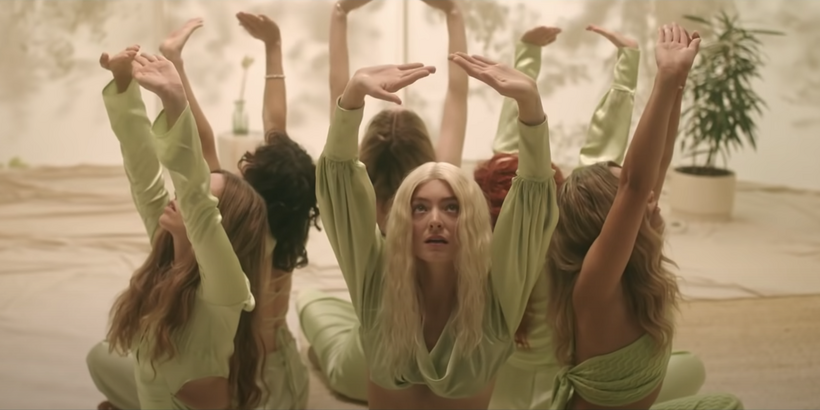By their very nature, cults have always preyed on the susceptibilities of their victims, but these days they’ve been playing to the sensibilities of the masses. Cults—or, rather, the idea of them—have gone strangely mainstream in pop culture and fashion.
Beginning with Margaret Qualley’s characterization of a youthful, fun-loving hippie (who also happens to be a Manson-family member) in the film Once upon a Time … in Hollywood, and now Nicole Kidman’s turn as a witchy wellness guru, a character who might have been torn from a cult leader’s playbook, in the television mini-series Nine Perfect Strangers, cults are starting to seem like the place to be.

But let’s start with Lorde, the singer-songwriter from New Zealand born Ella Marija Lani Yelich-O’Connor. Since arriving on the music scene with her debut album, Pure Heroine, eight years ago, Lorde, moody and soulful, has enchanted her fans with a certain goddess-like mystique.
Her latest album, Solar Power, and its accompanying imagery, however, has more than a few admirers wondering if there’s a hidden subtext to decode.
In the video for the album’s titular song, Lorde frolics and skips on a sunny beach, wearing a bright-yellow midriff-baring outfit, and is eventually joined by a curious ensemble of beige-clad extras whose bland, generic attire strips away any sense of individuality. They’re less supporting cast members than a single mass of generic, inferior beings.
It’s unexpected and puzzling, and more than a bit creepy. But because this is Lorde, a pop-culture unicorn who can arguably do no wrong, who are we to turn down whatever Kool-Aid she’s passing around these days?
The video for the Lorde’s track “Mood Ring” features a similarly matching cast of disciples, this time languidly entangled and draped atop one another in various states of repose (or are they sedated?), as Lorde holds a smoking piece of palo santo, a de rigueur prop that’s become synonymous with the woo-woo set in recent years. It’s commonly believed that burning small pieces of the South American wood as incense will clear spaces of negative energy. (Meanwhile, more legitimate practitioners of rain-forest medicine have said its widespread popularity stinks of cultural appropriation.)
Lorde’s platinum-blond wig makes an even more obvious nod to the wellness movement and its Goopiest figures, some of whom have been likened to cult leaders in their own right.
Indeed, the more the skeptics publicly criticize these profiteering, genetically blessed idols (who often tend to be hawking miracle-promising products, such as jade eggs that are guaranteed to work wonders on the vagina), the more devoted their worshippers become. (Even after being fined $145,000 in civil penalties for “unsubstantiated marketing claims,” Gwyneth Paltrow’s “yoni eggs” are still for sale on Goop’s Web site.) All rational thinking goes out the window when there’s better sex, more lustrous hair, or glowing skin to be achieved.

Then there’s all the airy and unstructured, caftan-like dressing that is infiltrating every segment of the fashion market. Between last year’s interminable lockdowns (why bother with pants when you’re not leaving the house?) and our collective distaste for almost any garment with a waistband, suddenly caftans, muumuus, and other tunic-like pieces don’t seem so reproachable after all.
All rational thinking goes out the window when there’s better sex, more lustrous hair, or glowing skin to be achieved.
There’s something to be said for comfort, but the sameness of it all might start to look like the robes of the Rajneesh cult—especially now that we’re going out in public again. And everyone’s wearing matching Birkenstocks.
The designer Tory Burch has opted for a more fashionable approach to the cult of caftans, with recent collections showcasing streamlined, minimalist looks that veer away from her usual stylized offerings.

Burch told reporters that a visit to Hancock Shaker Village, in Massachusetts, where the former residents practiced communal living, inspired her summer collection’s roomy, tunic-like silhouettes (and in shades evocative of canvas or even burlap), while her new fall collection bears a similarly pared-down, minimalist, and rather unsexy aesthetic. Let it be noted: the Shakers didn’t believe in procreation.
Or take Max Mara’s recent resort collection featuring silky and ethereal ankle-grazing cream-colored caftans with pockets at the breast, or perhaps any one of the numerous (and near-identical) faded-pastel sheaths worn by an army of barefoot models on Rodarte’s spring 2022 runway last week.
“You have all come here to die. And I will bring you back,” Nicole Kidman’s character in Nine Perfect Strangers announces to her guests, who have enrolled themselves for 10 days of total transformation. It’s exactly the sort of thing a cult leader might proclaim. And it sounds fabulous.
Laura Neilson is a New York–based writer


